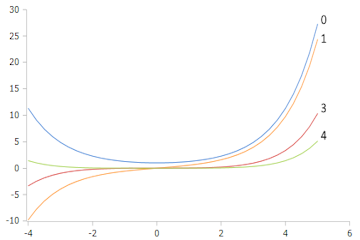Modified Bessel-I Function for Complex Numbers
Calculation of the modified Bessel function \(I_\nu(z)\) of the first kind for complex arguments
Bessel-I Function Calculator
Modified Bessel Function \(I_\nu(z)\)
The modified Bessel function \(I_\nu(z)\) of the first kind exhibits exponential rather than oscillatory behavior and is a solution to the modified Bessel differential equation.
Bessel-I Properties
Behavior
Exponential
Grows with |z|
Non-oscillatingKind
First Kind
Type: \(I_\nu\)
Regular at originOrder
ν ∈ ℝ
Any real number
Integer or rationalArgument
z ∈ ℂ
Complex: a+bi
Real and imaginary partImportant Properties
- Solution of the modified Bessel DDE
- Exponential growth for large |z|
- Symmetry relation: \(I_{-n}(z) = I_n(z)\) for integer n
- Limit: \(\lim_{z \to 0} I_\nu(z) = 0\) for ν > 0

Plot of the Bessel-I function with orders 0, 1, 3, and 4
|
|
Mathematical Definition of the Modified Bessel Function
The modified Bessel function of the first kind \(I_\nu(z)\) is defined by:
Power Series Expansion
Where \(\Gamma\) is the gamma function
Relationship to Bessel-J Function
Transformation of the ordinary Bessel function
Modified Bessel DDE
Differential equation with solution \(w = I_\nu(z)\)
Important Formulas and Properties
Symmetry Relations
Important symmetry properties of the function
Asymptotic Behavior
Exponential growth for large arguments
Special Values
Values at the origin
Recurrence Relations
Relationships between different orders
Applications and Practical Examples
Heat Conduction
Electromagnetism
Cylindrically symmetric modes
TM and TE modes
Radiation characteristics
Far-field approximation
Quantum Mechanics
Hydrogen atom
Coulomb potential
Radial wave functions
Mechanics & Acoustics
Membrane vibrations
Drumhead modes
Sound propagation
Resonance frequencies
Bessel Functions - Detailed Mathematical Description
Historical Context
Bessel functions were originally defined by the mathematician Daniel Bernoulli in connection with vibrations of a hanging chain and later generalized and systematically studied by Friedrich Wilhelm Bessel.
• Ordinary Bessel Functions: \(J_\nu(z)\), \(Y_\nu(z)\)
• Modified Bessel Functions: \(I_\nu(z)\), \(K_\nu(z)\)
• Hankel Functions: \(H_\nu^{(1)}(z)\), \(H_\nu^{(2)}(z)\)
Modified vs. Ordinary Bessel Functions
While the ordinary Bessel functions \(J_\nu(x)\) oscillate for real arguments, the modified Bessel functions \(I_\nu(x)\) exhibit exponential behavior. This property makes them particularly suitable for describing diffusion processes and exponentially growing or decaying phenomena.
Important Differences
Ordinary Bessel Function \(J_\nu(x)\): Oscillates and decays like \(\sqrt{\frac{2}{\pi x}} \cos(x - \frac{\nu\pi}{2} - \frac{\pi}{4})\)
Modified Bessel Function \(I_\nu(x)\): Grows exponentially like \(\frac{e^x}{\sqrt{2\pi x}}\)
Complex Arguments
For complex arguments z = x + iy, the Bessel functions extend to analytic functions of the complex plane. The modified Bessel function \(I_\nu(z)\) retains its characteristic properties.
• Analytic continuation to all of ℂ
• Branch points at z = 0
• Asymptotic behavior for |z| → ∞
Differential Equation
The modified Bessel function \(I_\nu(z)\) is a solution of the modified Bessel differential equation:
This equation differs from the ordinary Bessel DDE by the sign of the \(z^2\) term.
Numerical Calculation
Various methods are used for practical calculation:
- Power series: For small |z|
- Asymptotic expansion: For large |z|
- Recurrence relations: Between different orders
- Integral representations: For special applications
Extended Mathematical Properties
Integral Representations
For Re(z) > 0
Generating Function
Laurent expansion
Addition Theorems
Under certain conditions
Practical Calculation Tips
- Small arguments: Use power series
- Large arguments: Asymptotic formulas
- Integer order: Utilize recurrence relations
- Complex arguments: Beware of branch cuts
- Numerical stability: Consider scaling
- Precision: Sufficient terms in series expansion
Bessel Functions - Complete Definitions
Bessel Functions of the First Kind (\(J_\nu\))
The Bessel function of the first kind of order n is defined as:
Here \(\Gamma\) is the gamma function. At the origin (\(z = 0\)) these functions are finite for integer values of \(\nu\). For integer values of \(\nu\), the relationship holds:
Bessel Functions of the Second Kind (\(Y_\nu\))
The Bessel function of the second kind of order n is defined as:
Modified Bessel Functions (\(I_\nu, K_\nu\))
The modified Bessel function of the first kind of order n is defined as:
The modified Bessel function of the second kind of order n is defined as:
Important Properties
These functions play an important role in describing vibrations of a circular membrane, electromagnetic waves in cylindrical waveguides, heat conduction in cylindrical objects, acoustic membranes, and much more. They are an indispensable tool for many problems of wave propagation and static potentials in physics and engineering.
|
|
|
|
More complex functions
Absolute value (abs) • Angle • Conjugate • Division • Exponent • Logarithm to base 10 • Multiplication • Natural logarithm • Polarform • Power • Root • Reciprocal • Square root •Cosh • Sinh • Tanh •
Acos • Asin • Atan • Cos • Sin • Tan •
Airy function • Derivative Airy function •
Bessel-I • Bessel-Ie • Bessel-J • Bessel-Je • Bessel-K • Bessel-Ke • Bessel-Y • Bessel-Ye •